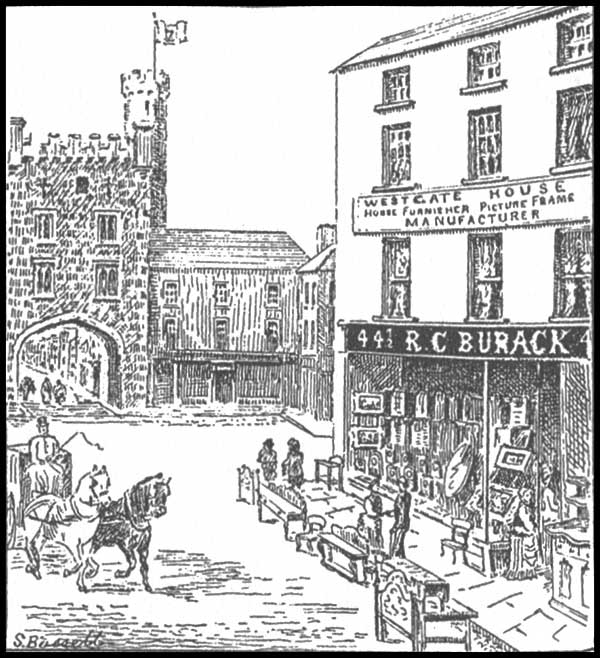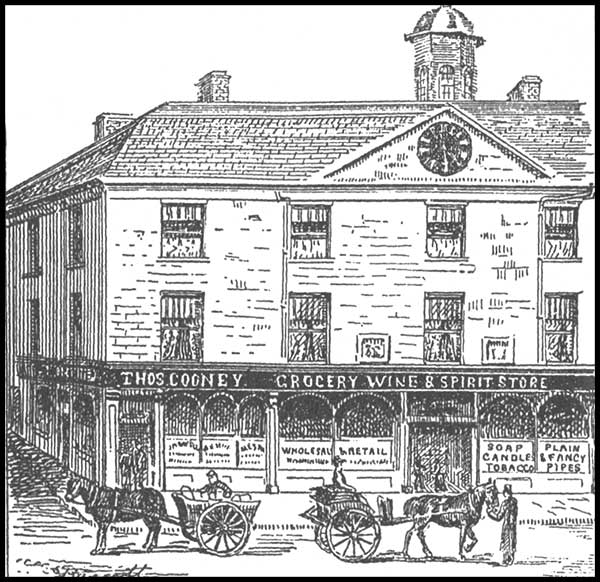Clonmel Castles, Walls and Gates, Old Houses, Main Guard, &c - Book of County Tipperary, 1889
About “The Book of County Tipperary,” 1889
George Henry Bassett produced 7 Irish county directories in the 1880s: Antrim, Armagh, Down, Kilkenny, Louth, Tipperary and Wexford. Each provides useful history of the respective counties as well as lists of office holders, farmers, traders, and other residents of the individual cities, towns and villages.
The directories are naturally an invaluable resource for those tracing family history. The Book of County Tipperary is the first of these to be made available on libraryireland.com, with its own search page. However, there are a few points to bear in mind.
- This online version is designed primarily as a genealogical research tool and therefore the numerous advertisements in the original book, many full page, and quite a few illustrated, have been excluded.
- The text has been proofed with due care, but with large bodies of text typographical errors are inevitably bound to occur.
- Be aware that there were often inconsistencies in spelling surnames in the 19th century and also that many forenames are abbreviated in Bassett’s directories.
With respect to the last point, surnames which today begin with the “Mc” prefix, for example, were often formerly spelt as “M‘,”. For a list of some of the more common forename abbreviations used in the directory, see Forename Abbreviations.
To enjoy the rich variety of advertisements, confirm accuracy of the entries, or have a printed record of a family member, obtain an original or facsimile copy of The Book of County Tipperary.
The antiquity of the defense works of Clonmel is indicated in the charter granted by James I. to the Corporation, 1609. It states that the town “from the foundation,” had been secured, and “on all sides surrounded with towers, castles, walls and fortresses,” for the repairs of which the inhabitants had been at “great and heavy expense and labor.” The remnants of many ancient buildings exist in different parts of old Clonmel. In the yards of several of the houses at both sides of the Main-street, the most interesting of these are to be found. Some writers have fixed the site of the principal castle at the back of 75 Main-street, the business house of Alderman P. Nugent. In a small garden here, now belonging to Messrs. P. & T. Murphy, there is a piece of a tower about eighteen feet high. It was once in possession of the Hackett family, and was decorated with mosses and shells for a tea house. Massive foundations in other parts of the premises of Messrs. Murphy, easily suggest the probable situation of a large castle with an outlet toward the river. The character of the building at the opposite side of the street is not inconsistent with the opinion that it either formed part of the castle or had a connection with it. This building is the warehouse of Messrs. Grubb & Sons. The original walls are from four to five feet thick. There are great cellars with communicating door-ways of cut stone. A passage leads from these to a narrow tower at the outside of the main wall, to the rere.
An idea of the extent of fortified Clonmel may be formed from the position of the remaining wall and the location of the gates. The wall partly encloses the grave-yard of St. Mary’s Protestant Church, and is in a good state of preservation. It has the usual arched recesses, now employed for supporting memorial stones at graves. There are three towers. One of these was occupied as a dwelling by a sexton of St. Mary’s for many years. The present sexton has chosen for his residence the smaller of the towers of St. Mary. The existing town wall runs round to a point within a short distance of the West Gate, an illustration of which appears at page 90. The West Gate of the present is a modern structure, the property of Lord Donoughmore. It was rebuilt on a larger scale in 1831. From the West Gate the wall was continued to the river, and thence along the bank to the South, or Water Gate, at the foot of Duncan-street. The wall ran from St. Mary’s Church to the North Gate, which stood at the point where Gladstone-street joins Upper Gladstone-street. The East Gate stood where Parnell-street joins Dublin-street. The walls were repaired and fortifications strengthened in 1691.

One of the curious old houses yet habitable, is occupied as the private residence of Mr. Benjamin Wright, who was mayor in 1886, when the Corporation substituted the name of Parnell for Bagwell, and of Gladstone for Johnson, in renaming two of the leading thoroughfares. Mr. Wright’s house is in Main-street. Number 19. It is believed to have been used for quarters by the Cromwellian officers in 1650, and was also at one time a bishop’s palace. A broad oak stairs is one of the attractive features. In 1880. while putting on a new roof, Mr. Wright discovered in the rafters, several letters bearing the signature of Oliver Cromwell. They soon crumbled away.
The Main Guard, an illustration of which appears at page 84, seems to have been built by the Corporation, from a design by Sir Christopher Wren, and for a long time was known as the Tholsel. It is situated at the eastern extremity of the Main-street, and was called the Main Guard because at one time the main guard of soldiers was on duty at this point of the town. At the south-west corner of Main street, opposite, the old market stone remains. This was used for payments “on the nail.” In June, 1774, the Corporation paid two sums of £31, and £4 4s. for repairs to the cupola, and the clock continues to be maintained by the same authority. The Deeds Committee of the Corporation, 1864, found that a head rent was paid out of the Tholsel from Mrs. Sylvia S. M‘Swyny of Dublin, to Mr. John Bagwell of Marlfield, head landlord of the greater portion of the town. The Committee refers to the Corporate Inquiry, instituted by the Government in 1833. Mr. David Malcomson, one of the witnesses then examined, testified that the Tholsel had been converted into three shops in or about the year 1810.

